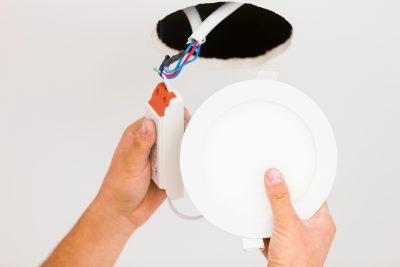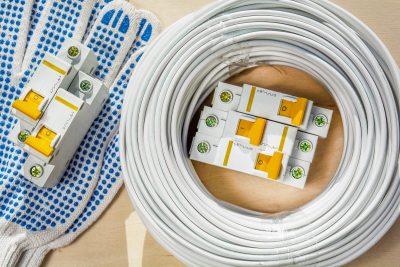Energy-saving solutions include smart electrical solutions that start with innovative technologies, helping to make informed choices. Smart thermostats, LED lights, and control systems for the optimization of energy usage in homes and businesses are some examples.
The solutions reduce the utility bills, thus leading to a cleaner environment. Energy-efficient devices will give us safer, smarter, and more economical electrical solutions tailored to your needs, especially if you reach out to us at TurnKey Electricals.

Automated energy management is the basis upon which smart electrical solutions are built. Focused on energy efficiency, these solutions aim to cut excess energy consumption in an attempt to make the environment and surroundings a bit more comfortable, thereby assisting in the automation of energy management.
Smart home technologies include all connected devices and appliances that can be remotely controlled-from programmable thermostats to smart plugs and smart lighting that learns user habits to provide maximum comfort with minimum energy consumption. For example, a smart thermostat may set the heating or cooling system to save energy while no one is at home.
Some key components here are smart lighting, energy-monitoring equipment, and automated outlets. Smart lighting gives you accurate control of light intensity and timings, while energy monitors will let you know which of your appliances consumes more energy. Automated outlets can be programmed so that they turn off your devices at peak demand, thus saving on energy costs.
Unlike the passive manual nature of older-generation systems, smart solutions can operate automatically due to the incorporation of sensor and algorithm technology; that means they operate in real-time.
The integration of intelligent devices into energy management systems represents a significant advancement in the pursuit of energy efficiency across various sectors. These devices, often equipped with advanced sensors, machine learning algorithms, and real-time data analytics capabilities, enable users to monitor and optimize energy consumption with unprecedented precision.
These devices learn routines, and when homes are empty, they switch off heating and cooling systems to save energy. For example, usage reports tell you about possible savings from the Nest Thermostat.
In addition to LEDs, systems such as Philips Hue can program lights, dim them, and switch their colors. Sensors, which are used in combination, will turn lights on and turn them off when a person or pet moves around.
These types of appliances are monitors and controllers of the energy consumed by single appliances, being done altogether to reduce the wastage of standby electricity. Some companies offer usage reports for the appliances in use to identify power-eaters, such as TP-Link Kasa.
Time-based communications enable bidirectional flow of both communication as well as energy. This means the amount of energy consumed in real-time is available at the end of the services and their consumers.
Smart solutions can save energy without compromising comfort. By implementing these strategies, we can cut energy costs and enhance sustainability.
Begin an energy evaluation of your home by conducting energy audits with some tools, like smart plugs. HVAC systems and water heating account for more than 40% of energy consumption and are therefore excellent targets for improvements.
Choose the most compatible energy-efficient smart appliances to suit your lifestyle. Smart thermostats such as the Nest or Ecobee control heating and cooling depending on your lifestyle, while LED smart lights and smart power strips cut down on energy waste.
All devices must be set up correctly to attain optimum performance. Smart hardwiring and configuration ensure safety and mutual energy conservation.
Set up your lighting and HVAC systems for operation only when they are truly necessary. Very basic schedules, such as turning the lights on at dusk or lowering the thermostat when people are at work, can make great changes.
Use the apps or dashboards to track your energy usage and make adjustments for improved efficiency.

Upgrading to smart electrical solutions within their existing setups can increase energy efficiency without breaking the bank with a full technological upgrade. By focusing on retrofitting, strategic integration, and addressing potential compatibility concerns, we create systems that deliver modern convenience while preserving the functionality of current infrastructure.
A lot of houses require new wiring because it is now very outdated. Retrofitting of this kind will improve these systems to facilitate programming for smart devices such as smart lighting and thermostats. For instance, intelligent switches or dimmers will allow the same control through an app or voice command. Replacement with high-efficiency appliances, along with smart plugs, also reduces energy consumption but still allows older houses to maintain their character.
Smart solutions must have access to the infrastructure by the use of cheaper wireless technologies, such as Wi-Fi or Zigbee, to easily connect devices without much rewiring.
The smart hub does everything; it’s more than a control center. It also helps in energy management through lighting, HVAC controls, and security options. In addition to this, it allows smart panel installations that give insight into the energy consumption patterns of homeowners, enabling them to revolutionize their usage efficiently without compromising their comfort.
Implementation challenges arise from the space left between the older facility and the new smart device; electrical loads are analyzed and predictions are made before all the other surveys to infer the most suitable solution.
Normally, this would entail upgrading or replacing the breakers, outlets, and switches to require smart technology standards. It is sometimes difficult to connect a smart thermostat to an old HVAC system and might require additional wiring or an adapter to work.
Investing in smart home solutions typically costs $1,500 to $5,500. While this price may seem steep at first, thoughts of savings down the road make it beneficial. Estimates say that smart thermostats can reduce heating and cooling bills by 10-15%, or about $180 annually.
These energy-efficient systems save far more than the upfront costs of the systems in lowering the monthly energy bill. In addition to their energy savings, the efficiency of these systems is enhanced by features such as pre-cooling and pre-heating of the premises during off-peak hours. More energy savings are realized from smart lighting and automated shading.
Smart solutions enhanced with electronics give more control and improvement in energy efficiency. Devices such as smart thermostats, energy-efficient lighting, and smart plugs save energy and money while maximizing comfort. These tools fit seamlessly into existing setups, providing an easy transition.
We aim to empower people and institutions to conserve energy with smart technologies for convenience and sustainability. Begin your smart solution in cutting costs and safeguarding sustainable prospects. Call us at TurnKey Electricals now to discover how we can tailor energy management options to suit your needs.